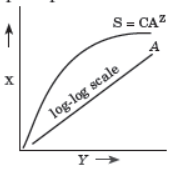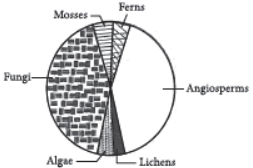Please refer to Assignments Class 12 Biology Biodiversity and Conservation Chapter 15 with solved questions and answers. We have provided Class 12 Biology Assignments for all chapters on our website. These problems and solutions for Chapter 15 Biodiversity and Conservation Class 12 Biology have been prepared as per the latest syllabus and books issued for the current academic year. Learn these solved important questions to get more marks in your class tests and examinations.
Biodiversity and Conservation Assignments Class 12 Biology
Question. Which among the following is the criterion for determination of ‘Biodiversity hot spot’ –
(a) Very high level of species richriess
(b) High degree of habitat loss and fragmentation
(c) High degree of Endemism
(d) All of the above
Answer
D
Question. Pattern of Biodiversity depends upon –
(a) Latitudinal gradient
(b) Altitudinal gradient
(c) Species – area relationship
(d) All of these
Answer
D
Question. From ‘The Evil Quartet’ which of the following is most important cause of biodiversity loss –
(a) Habitat loss and fragmentation
(b) Over – exploitation
(c) Alien species invasion
(d) Co-extinctions
Answer
A
Question. In India, how many genetically different strains of rice and mango varieties are present –
(a) <50,000 and 1,0000 respectively
(b) 1000 and 50000 respectively
(c) >50.000 and 1.000 respectively
(d) >50,000 and 5,000 respectively
Answer
C
Question. Find out incorrect statement –
(a) Biodiversity exists at all levels of biological organisation
(b) A single species cannot show more diversity at genetic level
(c) Western ghats have a greater amphibian species diversity
(d) India has greater ecological diversity than Scandinavian country.
Answer
B
Question. The most dramatic examples of habitat loss come from tropical rain forests. Once covering more that 14 present of earths land surface and now cover no more than –
(a) 5%
(b) 6%
(c) 10%
(d) 13%
Answer
B
Question. Careful analysis of records shows that extinction across taxa are not random, some groups like ______ appear to be more vulnerable to extinction.
(a) Reptiles
(b) Mammals
(c) Aves
(d) Amphibians
Answer
D
Question. The Amazon rain forest ‘lungs of Planet” harbouring probably millions of species is being cut & cleared for which purpose –
(a) For cultivation of soyabeans
(b) For conversion to grasslands for raising beef cattles
(c) For cuttivation of Medicinal plants
(d) Both (a) and (b)
Answer
D
Question. In species area relationship, on a logarithmic scale.
The relationship is –
(a) Rectangular hyperbola
(b) Rectangular parabola
(c) Straight line
(d) Sigmoid
Answer
C
Question. More species in community, tends to more stability than communities with less species’. It was supported by-
(a) David Tilman
(b) Paul Ehrlich
(c) Humboldt
(d) Tansley
Answer
A
Question. “Rivet popper hypothesis” was proposed by –
(a) Tilman
(b) Hombolat
(c) Paul Ehrlich
(d) Mayer
Answer
C
Question. Alien species invasion is one of the cause of Biodiversity loss. Introduction of Nile perch in victoria lake lead to extinction of more than 200 species of –
(a) Cichlid fish
(b) Gambusia
(c) Salmon fish
(d) Cat fish
Answer
A
Question. The recent illegal introduction of which African fish becomes severe cause of threatening of indigenous cat fishes –
(a) Gambusia
(b) Labeo
(c) Clarias gariepinus
(d) Dog fish
Answer
C
Question. Find out the following w.r.t. economic importance of biodiversity –
(a) Production of oxygen
(b) Pollination
(c) Medicinal utility
(d) All
Answer
C
Question. Match the following-
(a) Ants (i) 20,000 species
(b) Beetles (ii) >28,000 species
(c) Fishes (iii) >3,00,000 species
(d) Orchids (iv) >20,000 species
(a) a (iv), b (ii), c (iii), d (i)
(b) a (ii), b (iii), c (iv), d (i)
(c) a (iv), b (iii), c (ii), d (i)
(d) a (iii), b (ii), c (i), d (iv)
Answer
C
Question. In biosphere, diversity (heterogeneity) exist at –
(a) Species level
(b) Genetic level
(c) Ecosystem level
(d) All the above
Answer
D
Question. Find out the odd one with respect to ‘Biodiversity hot spots’ –
(a) Western Ghats & Srilanka
(b) Indo – Burma
(c) Himalaya
(d) Gangatic plains
Answer
D
Case Based MCQs
Read the following passage and answer the questions from 41 to 45 given below.
Within a region, species richness increases with increasing explored area, but only upto a limit.
The given graph explains this relationship.

Question. What does the given figure show?
(a) Rivet-popper hypothesis
(b) Species-area relationship
(c) Proportionate number of species of major taxa
(d) a-ecological diversity
Answer : B
Question. Who gave this concept of increase in species richness with increasing area?
(a) Humboldt
(b) Odum
(c) Edward Wilson
(d) Paul Ehrlich
Answer : A
Question. What is the value of slope of line or regression coefficient Z for frugivorous birds?
(a) 0.1-0.2
(b) 1.15
(c) 0.01-0.1
(d) 0.6-1.2
Answer : B
Question. The shape of curve for relationship between species richness and areas for a wide variety of taxa is
(a) straight line
(b) parabola
(c) rectangular hyperbola
(d) bell shaped.
Answer : C
Question. MAB Programme means
(a) Man and biosphere programme
(b) Man and biodiversity conservation programme
(c) Manually aided biosphere conservation programme
(d) none of these.
Answer : A
Question. Equation for relationship (A) between species richness and area is
(a) log S = log C + Z log A
(b) log C = log S + Z log A
(c) Z log A = log S + log C
(d) log S = log C + log A.
Answer : A
Assertion & Reasoning Based MCQs
For question numbers 51-58, two statements are given-one labelled Assertion and the other labelled Reason.
Select the correct answer to these questions from the codes (a), (b), (c) and (d) as given below.
(a) Both assertion and reason are true and reason is the correct explanation of assertion.
(b) Both assertion and reason are true but reason is not the correct explanation of assertion.
(c) Assertion is true but reason is false.
(d) Assertion is false but reason is true.
(iv) Tourism is allowed in Y zone only.
(v) Zone Y helps to maintain the lifestyle of the tribal people living in the area.
(a) (iii), (iv) and (v) only
(b) (ii), (iii) and (v) only
(c) (i), (iii) and (iv) only
(d) (ii), (iii) and (iv) only
Question. Assertion : Alpha diversity is said to be higher if the dissimilarity between communities is higher.
Reason : Alpha diversity is dependent upon species richness and evenness / equability.
Answer : D
Question. Assertion : Dodo, Passenger pigeon,Steller’s sea cow have become extinct due to over exploitation.
Reason : Excessive exploitation of a species, whether animal or plants reduces size of its population so that it becomes vulnerable to extinction.
Answer : C
Question. Assertion : Maximum biodiversity occurs in temperate areas.
Reason : Tropical areas have favourable conditions for speciation and for supporting variety and number of organisms.
Answer : D
Question. Assertion : Buffer zone surrounds the core area and limited human activities like resource use strategies, research and education are allowed here.
Reason : There is no biotic interference except in buffer zone.
Answer : C
Very Short Answer Type Questions
Question. Name the type of biodiversity represented by the following:
(a) 1000 varieties of mangoes in India.
(b) Variations in terms of potency and concentration of reserpine in Rauwolfia vomitoria growing in different regions of Himalayas.
Answer : (a) Genetic diversity (b) Genetic diversity
Question. What is an exotic species?
Answer : New species entering a geographical region are called exotic species.
Question. Name the three zones of biosphere reserves.
Answer : Biosphere reserves have three zones: Core or natural zone: Undisturbed and legally protected area where no human activity is allowed. Buffer zone: Limited human activity like research, education and resource utilisation strategies are allowed. Transition zone: Outermost region where human activity like recreation, cropping, forestry, etc., are allowed.
Question. Eichhornia crassipes is an alien hydrophyte introduced in India. Mention the problems posed by this plant.
Answer : Eichhornia crassipes, an alien hydrophyte was introduced in Indian waters due to aesthetic value but it turned out to be a problematic species. It has clogged water bodies resulting in death of aquatic plants and animals.
Question. Mention one application of pollen bank. How are pollens stored in a bank?
Answer : Pollen banks are used to maintain stocks of biodiversity.
Pollens are stored in a bank at a very low temperature of –196°C in liquid nitrogen, i.e., by cryopreservation.
Short Answer Type Questions
Question. Study the given figure and answer the following questions.

(a) Identify the figure and the types of diversity labelled as A, B and C in it.
(b) Give a brief description of diversity labelled as A and C.
(c) Which of the diversities labelled as A, B and C will face maximum competition, adjustments and interrelationships amongst the members of the same community?
Answer : (a) The given figure is of ecological diversity. Here, A is alpha diversity, B is beta diversity and C is gamma diversity. (b) Alpha diversity (A) is a species diversity in a given community or habitat. Alpha diversity is dependent upon species richness and evenness/equitability. Gamma diversity (C) is a diversity present in ranges of communities as represented by diversity of habitats/ecosystems over a total landscape or geographical area. (c) Alpha diversity (A) will face maximum competition, adjustments and interrelationships amongst the members of the same community.
Question. (a) “India has greater ecosystem diversity than Norway”. Do you agree with the statement?
Give reasons in support of your answer.
(b) Write the difference between genetic biodiversity and species biodiversity that exists at all the levels of biological organisation.
Answer : (a) Yes, India has a greater ecosystem diversity than Norway as India comes under the tropical region whereas, Norway lies in temperate region. Tropical regions account for greater biological diversity as they have deserts, rainforests, mangroves, coral reefs, wetlands, estuaries and alpine meadows than temperate regions. In tropical region, more solar energy is available that also promotes higher productivity and increased biological diversity.
(b) Differences between genetic and species biodiversity are as follows :

Question. White Bengal tigers are protected in special settings in zoological parks. Tiger reserves are maintained in Western Ghat.
(a) How do these two approaches differ from
each other? Mention the advantages of each one.
(b) What is the significance of cryopreservation technique?
Answer : (a) In zoological parks, white Bengal tigers are protected outside their natural habitats. It is a mode of ex situ conservation. Animals are kept under human supervision and are protected against all adverse factors. Western ghats are hot-spots, i.e., areas of high endemism and high level of species richness. It is a mode of in situ conservation. Endangered species in Tiger reserves are conserved in their natural habitat. These are protected from predators. (b) Cryopreservation is ex situ conservation technique in which tissues, organs, embryos, seeds, etc., are stored at very low temperature of –196°C. At this temperature the living material can be stored indefinitely in compact, low maintenance refrigeration units. It can be revived as and when required.
Question. ‘In-situ’ conservation can help endangered/ threatened species. Justify the statement.
Answer : ‘In-situ’ conservation helps endangered and threatened species by protecting them in their natural habitats along with their ecosystem and its biodiversity. For example, National parks are the areas maintained by the government for better conservation of wildlife. It is a place where cultivation, grazing, forestry and habitat manipulation are restricted. Sanctuaries are places where wild animals can take refuge without being hunted. Activities like collection of forest products, private ownership land, tilling of land, etc., are allowed but animal hunting is prohibited. Biosphere reserves are meant for preserving genetic diversity in representative ecosystems of various natural biomes and unique biological communities by protecting wild populations, traditional life style of tribals and domesticated plant/animal genetic resources.
Question. Alien species are highly invasive and are a threat to indigenous species. Substantiate this statement with any three examples.
Answer : Non-native or alien species are often introduced inadvertently by man for their economic and other uses. They often become invasive and drive away the local species. For example: (i) Water hyacinth (Eichhornia crassipes) was introduced in Indian waters due to its aesthetic value but it turned out to be a problematic species. It has clogged water bodies including wetlands at many places resulting in death of several aquatic plants and animals. (ii) Nile Perch (a predator fish) was introduced in lake Victoria of East Africa. It killed and eliminated ecologically unique assemblage of over 200 native species of small cichlid fish. (iii) African catfish (Clarias gariepinus) introduced for aquaculture in India possess threat to indigenous catfishes.
Question. Mention the kind of biodiversity more than a thousand varieties of mangoes in India represent. How is it possible?
Answer : “More than a thousand varieties of mango in India” exhibit genetic diversity. Genetic diversity represents the diversity in number and types of genes as well as chromosomes present in different species and variations in the genes and their alleles in the same species. The reason for this genetic diversity is the occurrence of variations in environmental parameters and use of horticulture techniques like grafting, breeding, etc.
Question. The sacred groves of Aravalli Hills and Ooty botanical garden both aim at biodiversity conservation. How do they differ in their approaches? Explain.
Answer : Sacred groves are undisturbed forest patches, surrounded by highly degraded landscapes where not even a single branch of tree is allowed to be cut. As a result, many endemic species which are rare or have become extinct, seen to flourish here. While botanical gardens are areas where many species of plants, are conserved outside their natural habitats. They help to restore endangered species, whose chances of survival are very small. Thus, sacred groves of Aravalli Hills are sites of in-situ conservation, where endangered species are protected in their natural habitat whereas Ooty Botanical gardens are sites of ex-situ conservation, where the endangered species are protected outside their natural habitats.
Question. List any four techniques where the principle of ex situ conservation of biodiversity has been employed.
Answer : Four techniques where principles for ex situ biodiversity conservation has been employed are:
(i) Orchards – Plants with recalcitrant seeds are grown in orchards where all possible strains and varieties are maintained, e.g., litchi.
(ii) Cryopreservation – Cells, embryos, tissues are preserved at – 196°C.
(iii) Seed banks – Storing viable seeds at low temperature, and germinating them to obtain fresh seeds.
(iv) Tissue culture – Production of large number of plants through callus culture, pollen grain culture, embryoids, etc.
Question. What is IUCN red list? Give any two uses of this list.
Answer : IUCN red list is a catalogue of taxa facing risk of extinction. The two uses of this list are:
(i) It provides awareness to the degree of threat to biodiversity.
(ii) It is useful in identification and documentation of species which are at high risk of extinction.
Question.

Observe the global biodiversity distribution of major plant taxa in the above diagram and answer the questions that follow.
(a) Which group of plant are most endangered?
(b) Why are mosses/ferns so few? Give reason.
(c) How do fungi that are heterotrophs sustain themselves as a large population?
(d) Which group of plant is most advanced and which one is most primitive?
Answer : (a) As per the given pie chart lichens are least in number, also lichens are pollution sensitive so with increasing globalisation we can assume that in near feature lichens will be subject to extinction and hence may be considered as most endangered among the given taxas. (b) Mosses and ferns grow in shady and humid places or wet places and need water for fertilisation. Hence, they are few in numbers. (c) Fungi can live as saprotrophs or parasites. As saprotrophs, they depend on only organic matter and hence survive in any environment. They produce a number of thick walled spores, which can withstand the unfavourable conditions and germinate when conditions become favourable. This helps fungi in sustaining a large population. (d) Angiosperms are the most advanced whereas fungi are the most primitive.
Question. (a) Explain the concept of endemism.
(b) Name four regions in an around our country that are considered hotspots.
Answer : (a) Endemism is the ecological state of a species being unique to a defined geographical location such as an island, nation, country or other defined zone. E.g., The Tasmanian Devil is the largest carnivorous marsupial in the world and found only on the Australian island state of Tasmania.
(b) Western Ghats and Sri Lanka, Indo-Burma and Himalayas are hotspots in India. Others include mountains of southwest China, Caribbean Island hotspot, etc.
Question. Many plant and animal species are on the verge of their extinction because of loss of forest land by indiscriminate use by the humans. As a biology student what method would you suggest along with its advantages that can protect such threatened species from getting extinct?
Answer : Conservation of biodiversity is protection, uplift and scientific management of biodiversity so as to maintain it at its optimum level and derive sustainable benefits for the present as well as future generations. There are two types of conservation strategies – in situ (on site) and ex situ (offsite). In situ conservation is conservation and protection of the whole ecosystem and its biodiversity at all levels in their natural habitat in order to protect the threatened species. It involves hotspots and protected areas. Hotspots are areas of high endemism and high level of species richness. Protected areas are ecological/biogeographical areas where biological diversity along with natural and cultural resources is protected, maintained and managed through legal or other effective measures. Protected areas include national parks, sanctuaries and biosphere reserves. Ex situ conservation is conservation of threatened plants and animals in places outside their natural homes under full protection and supervision. It includes offsite collections and gene banks.
Long Answer Type Questions
Question. (a) Why should we conserve biodiversity? How can we do it?
(b) Explain the importance of biodiversity hotspots and sacred groves.
Answer : (a) Conservation of biodiversity is the protection, uplift and scientific management of biodiversity so as to maintain it at its optimum level and derive sustainable benefits for the present as well as future strategies. The maintenance of a high level of biodiversity is important for the stability of ecosystem. The main reasons to conserve the biological diversity can be grouped in three categories : – Narrowly utilitarian (useful products for humans like food, fibres, drugs and medicines etc.) – Broadly utilitarian (ecosystem services like provision of pollination, climate regulation, flood and erosion control, ecological balance through nutrient cycling, microbial waste treatment, biological pest control, aesthetic and cultural values). – Ethical (every living species has an intrinsic value though it may not have any direct economic value, and also, every species has the right to live). The two types of conservation strategies are in situ (on site) and ex situ (off site). In situ conservation is conservation and protection of the whole ecosystem and its biodiversity at all levels in their natural habitat in order to protect the threatened species. It involves hotspots and protected areas. Hotspots are areas of high endemism and high level of species richness. Protected areas are ecological/biogeographical areas where biological diversity along with natural and cultural resources is protected, maintained and managed through legal or other effective measures. Protected areas include national parks, sanctuaries and biosphere reserves. Ex situ conservation is conservation of threatened plants and animals in places outside their natural homes under full protection and supervision. It includes offsite collections and gene banks.
(b) ‘Biodiversity hotspots’ are the regions which are characterised by very high levels of species richness and high degree of endemism. India has three hotspots – Indo-Burma (North-East India), Himalayas, and Western Ghats. Importance of hotspots are as follows: – Maintaining genetic diversity of all present species and varieties. – Maintaining viable populations of native species, subspecies and varieties. – Maintaining resilience in species/habitats/ecosystems to adapt to environmental changes. – Maintaining the various types of communities/ ecosystems/habitats both in number and distribution. – Checking human aided introduction of alien/exotic species. Sacred forests or sacred groves are forest patches around places of worship which are held in high esteem by tribal communities. They are the most undisturbed forest patches (island of pristine forests) which are often surrounded by highly degraded landscapes. They are found in several parts of India, e.g., Karnataka, Maharashtra, Rajasthan (Aravalli), Chandigarh (Sarguja, Chanada and Bastar), Kerala, Meghalaya. Temples built by tribals are found surrounded by deodar forests in Kumaon region. In Meghalaya scared groves are found in Jaintia and Khasi hills. Not a single branch is allowed to be cut from these forests. As a result, many endemic species which are rare or have become extinct elsewhere can be seen to flourish here. Bishnois of Rajasthan protect Prosopis cineraria and Black Buck religiously. Some water bodies are also held sacred in certain places, e.g., Khecheopalri in Sikkim. Their aquatic flora and fauna are naturally preserved.
Question. (a) According to ecologists, tropical regions in the world account for greater biological diversity. Justify.
(b) Why are habitat loss and alien species invasion considered as the causes of biodiversity loss? Explain with the help of an example of each.
Answer : (a) On the land, maximum primary productivity is found in tropical rainforest. Various factors which contribute to high productivity in tropics are discussed ahead. Maximum light is available in tropics. Due to this photosynthesis is maximum and net primary productivity is highest in tropics. Climate of tropics is warm and humid. Appropriate temperature, rain and humidity increase productivity of tropics. Moreover, ecosystem with higher biodiversity are more productive.
(b) Loss of habitat results in annihilation of plants, microorganisms and forcing out of animals which in alien lands die out after sometime due to unfavourable conditions. Fragmentation of habitats results in disruption of complex interactions among species and animals requiring large territories are badly affected. E.g., mammals and birds. Alien species often become invasive and drive away the local species. They have proved harmful in both aquatic and terrestrial ecosystems. E.g., water hyacinth was introduced in Indian waters to reduce pollution. It clogged water bodies at many places resulting in death of several plants and animals.



